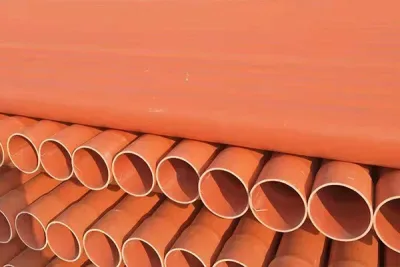CPVC cable pipe
Polyvinyl chloride is modified by chlorination to obtain the high-performance material chlorinated polyvinyl chloride (CPVC). After modification, the service temperature, chemical resistance, aging resistance and flame retardant and smoke elimination properties of polyvinyl chloride (PVC) have been greatly improved. Its comprehensive performance exceeds that of general ABS.

CPVC ELEC PIPES Ø50-315

CPVC ELEC PIPES Ø50-315

CPVC ELEC PIPES Ø50-315

CPVC ELEC PIPES Ø50-315

CPVC ELEC PIPES Ø50-315

CPVC ELEC PIPES Ø50-315

CPVC ELEC PIPES Ø50-315

CPVC ELEC PIPES Ø50-315
Using a mixture of PVC resin and CPVC resin as the basic raw material reduces raw material costs, and through ACR impact modifier, CPE impact modifier and MBS resin, these three impact modifiers are used to modify the basic raw materials. CPVC resin is modified to improve its low-temperature embrittlement, improve its processing performance, and increase impact strength; and rational use of light calcium, PE wax, molybdenum camellia and paraffin wax improves its fluidity and avoids problems during continuous production. The reasonable design of paste and mold blocking ensures production efficiency while avoiding waste of raw materials and increase in production costs, and is easy to clean.
raw materials
The materials used in chlorinated polyvinyl chloride plastic cable conduits should be mainly chlorinated polyvinyl chloride resin and polyvinyl chloride resin, with additives that are beneficial to improving the mechanical and processing properties of the conduit. The additives should be evenly dispersed, and no additives are allowed to be added to the mixture. plastic. The chlorine content in the chlorinated polyvinyl chloride resin should be no less than 67% (mass percentage), and the addition of no more than 5% clean recycled material is allowed. [2]
The material used in rigid polyvinyl chloride plastic cable conduits should be mainly polyvinyl chloride resin, with additives that are beneficial to improving the mechanical and processing properties of the conduit. The additives should be evenly dispersed. No additional plastic is allowed to be added to the mixture, and the amount allowed is no more than 5 % of clean recycled materials. [2]
Q/TD 802.3—20102.2 Appearance, dimensions [2]
color
The color of the conduit should be uniform. There is a clear difference between the color of chlorinated polyvinyl chloride cable conduit and rigid chlorinated polyvinyl chloride cable conduit, which can also be agreed upon by both parties. [2]
Appearance Quality
The inner and outer walls of the conduit are not allowed to have bubbles, cracks, obvious marks, dents, impurities, decomposition and discoloration lines, uneven colors and other defects; the inner wall of the conduit should be smooth and flat; the end face of the conduit should be cut flat and perpendicular to the axis; when processing the outer wall of the socket end There should be chamfering; when processing the socket end, a draft angle of no more than 1° is allowed, and there must be no deflection. [2]
size
Dimensional deviations shall comply with the requirements of Q/TD 802.3.
